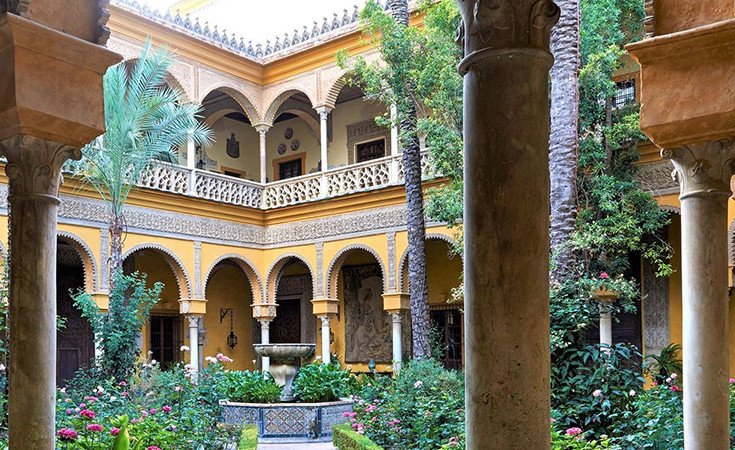
Duenas Palace is a palace built at the end of the 15th century in the Renaissance style with noticeable Gothic and Moorish influences and today belongs to the House of Alba. Seville's great architectural and artistic heritage is housed in this flowery palace.
Important weddings took place in the flower palace. The most significant of them was the wedding of the Duchess of Alba to Cayetán Fitz James Stewart. This was her third wedding in this particular palace. In 1931, the palace became a National Monument, but it was only in 2016 that the palace was opened for tourist visits, and the opening ceremony was held by Duke Carlos Fitz James Stewart, who got married here. This is one of Seville's most visited cultural monuments.
This romantic palace was built at the end of the 15th century. The Pineda family contributed funds for the construction. Pedro Pineda was then the mayor of Seville. He and his wife María sold their home to the widow of the governor, Don Pedro Enriquez, in order to raise enough money to ransom Don Juan de Pineda, who had been captured by the Moors.
In later years, the palace expanded and developed, changed its shape and size, and was under the patronage of Fernando Enrique de Ribera. When the fifth Marchioness married the fourth Duke of Alba, this palace became the property of the Alba family. Lord Holland, a great admirer of Spanish literature, lived in this palace for a time. In the palace, the poet Macado lived in his early childhood, while his father worked as a guard for the Duke of Alba.
The palace got its name from the monastery of Santa Maria de las Duenas, where nuns lived in 1248 who served St. Ferdinand and Alfonso the Wise. This monastery was located near the palace, but was demolished in 1868. This palace underwent the most significant changes in the 18th and 19th centuries. The palace can be seen in the Renaissance, Gothic and Moorish style of construction. Bricks, cinders, tiles, and pottery were used for its construction, combined with white walls. Through the palace itself there are very long passages and an inner courtyard. The ceiling of this palace is decorated with golden alfar. In the past, this palace had 11 courtyards, 9 fountains and even 100 marble columns. Today, there is only one courtyard, with a much smaller number of marble columns. The courtyard of the palace is a typical Andalusian courtyard.
The facade of the palace is covered with the "bogomil" flower, which gives the palace an incredible glow. The main and only courtyard garden of the palace is divided into four parts, so there is a central fountain, paved paths and smaller fountains as symbols of Macad's poetry. In the courtyard behind the palace, there are columns of distinctly white marble. The palace also has a chapel from the 15th century with an altar made of Seville ceramics from the 16th century. It is said that Amerigo Vespucci got married in this chapel. The palace has a collection of as many as 1452 artifacts, and you can see beautiful old furniture, salons, escajg, old chandeliers, ceramics, sculptures...
• Working hours: Every day from 10 a.m. to 18:00 p.m
• Entrance fee: with audio guide €12 per person
Reduced ticket price €10 - for children from 6 to 16 years old, for students and older then 65 years old as well as for people with disabilities.
Free entrance for children under the age of 6
Author of the text:

Maja Glavaš, Bachelor with Honours in Communicology. Works in Tourism.
Contact: [email protected]; instagram: travel_europe1